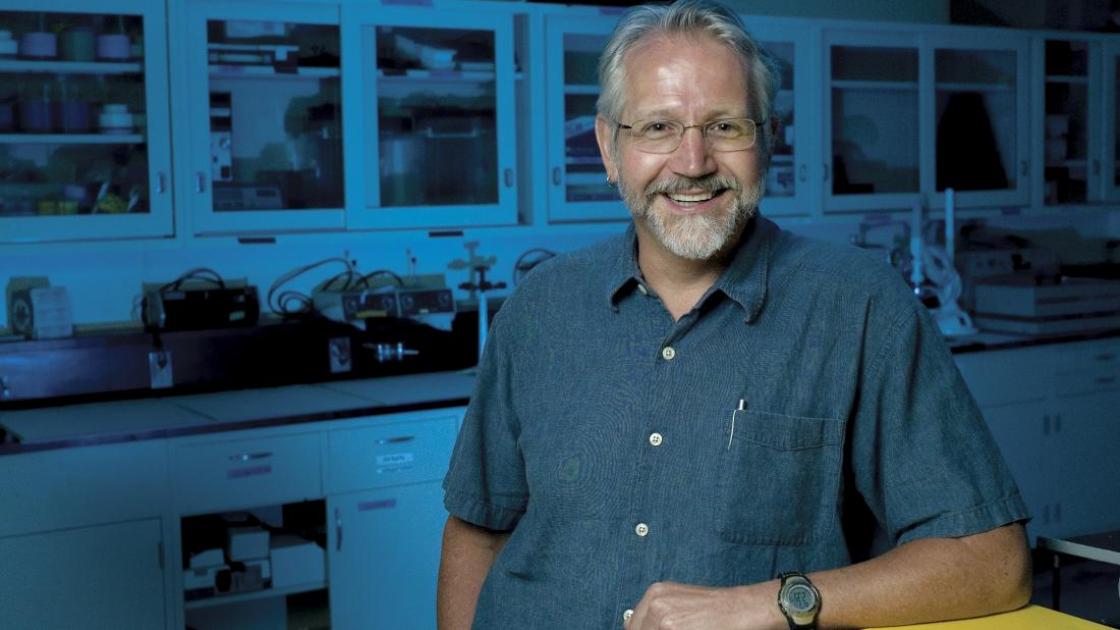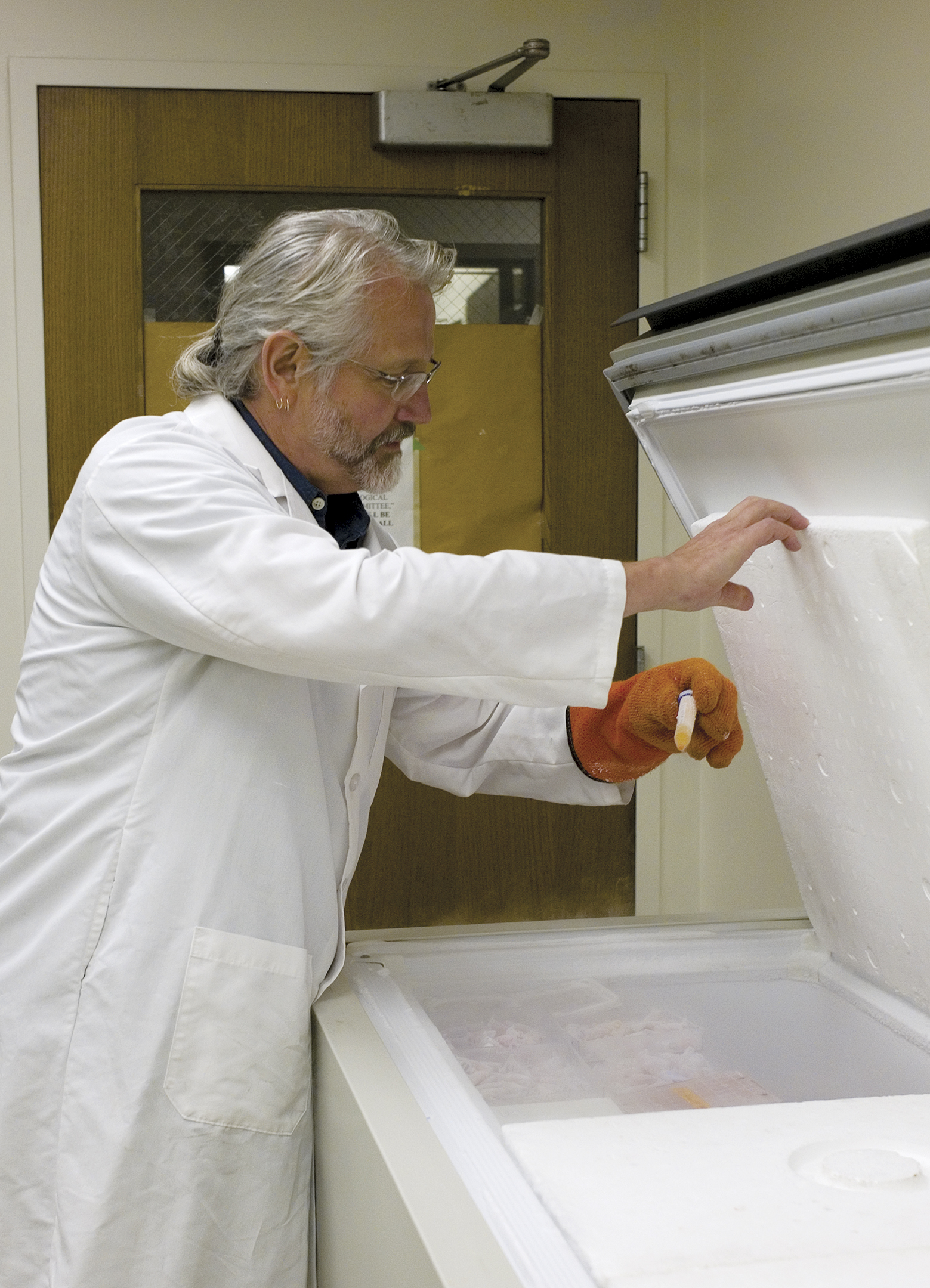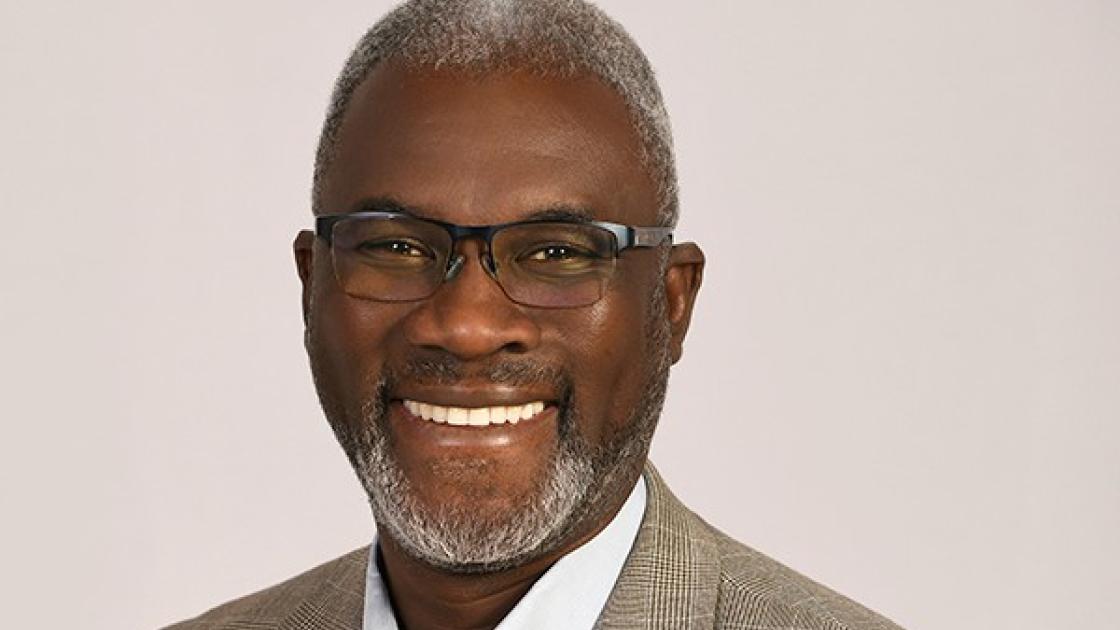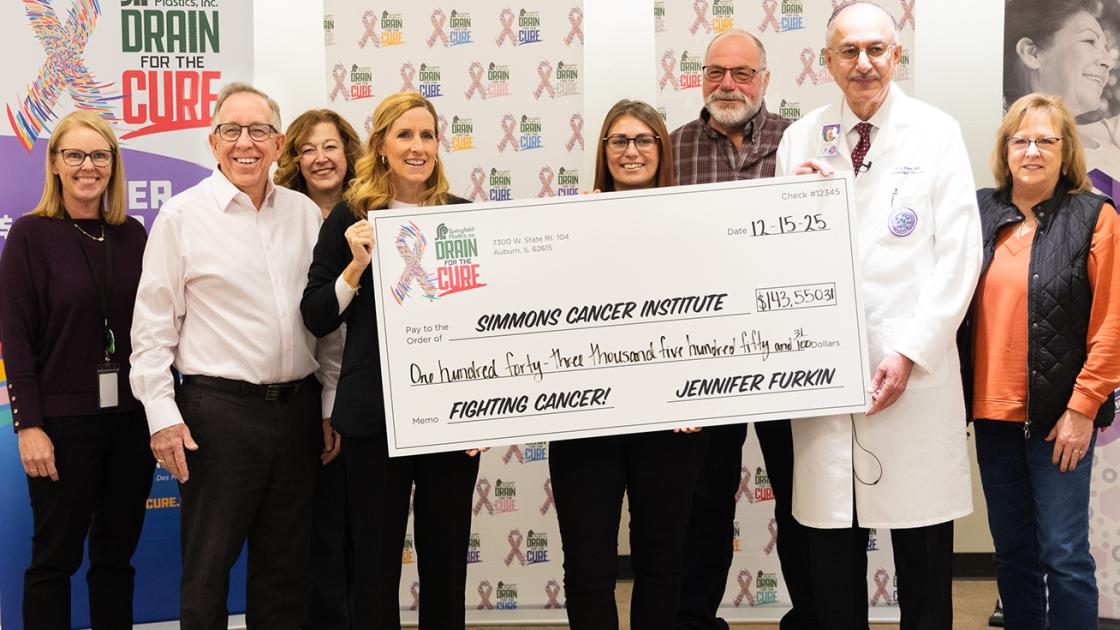
A Natural Fit
Dale Buck Hales, Ph.D., finds a new home at SIU School of Medicine
Written by Karen Carlson | Photographs by Jim Hawker
Published in Aspects. Autumn 2008 (32-4)
Dale Buck Hales, Ph.D., stood amid the towering grandeur of Giant City State Park and was in awe. The park was the first stop during his visit to Carbondale to interview for the position of chair of physiology at SIU School of Medicine. Dr. Hales was ready to hit the SIU campus, but former chairman Rick Steger, Ph,D., first took him to Giant City, a captivating introduction to the region and a profound change from Dr. Hales’ home in the Windy City. “In Chicago, we took candidates to one of the thousands of restaurants. You can’t find a place that’s more different from Chicago than Giant City State Park. I was stunned by the natural beauty of southern Illinois. The selling point of SIU and Carbondale is the beautiful natural surroundings.”
After two visits and more than 30 interviews, Dr. Hales joined the faculty in July as professor and chair of physiology. He also is a member of the research team at the SimmonsCooper Cancer Institute at SIU. “I just had the right chemistry with people,” he says.
Although he didn’t envision becoming a department chair, Dr. Hales formulated his vision: “I want to do everything to make sure that the hierarchy of researchers —who is funded, who is not — doesn’t exist. If faculty choose to devote talent and energy to teaching, they shouldn’t be scorned for teaching. The research really enriches our teaching mission. They really go together. Young faculty should be given the opportunity to have graduate students. It’s a positive experience for all concerned. My principles were things that were pretty much already the philosophy here, so it seemed a good match.”
His wife, Karen Held Hales, Ph.D., also joined the faculty as a tenure-track assistant professor of physiology. She has expertise in understanding RNA and micro RNAs – a hot topic in cancer. Along with their son, Ryder, a third-grader, all three have blended in nicely into campus life at SIU School of Medicine in Carbondale.
“It’s so much more relaxed here. It suits my temperament,” says Dr. Hales, sitting in a temporary office in Life Science II, dressed in a linen shirt, khakis and Crocs. Life in Carbondale and at SIU is proving to be a surprisingly good fit for a man who was a professor at the University of Illinois at Chicago for 20 years.
“I really loved living in Chicago; it’s a beautiful place, but it’s all concrete. It can take 90 minutes to drive eight miles.” In about 1999 Dr. Hales decided to brave the Chicago traffic to ride his bicycle the eight miles to work, partly through rough neighborhoods. “I was interested in the people, instead of being afraid of them. I thought if I could just talk to them, everything would be ok.” He and a small group of bicyclists became a familiar sight to the newspaper vendors they befriended. “It was a very humbling, but excellent experience,” Dr. Hales says.
The commute is shorter and a little safer in Carbondale, as Dr. Hales rides his Cannondale touring bicycle a short four miles to campus on most days. “I hardly have to stop, but there are really big hills here. And it’s much hotter.”
A knee injury led him into bicycling from running. He defines himself as a marathoner, competing in 21 marathons, including 50-mile and 50K ultramarathons. He’s also participated in four triathalons.
With his relaxed style, sporting a silver ponytail that curls at the ends and a double hooped earring, he more resembles an art professor than a reproductive biologist. He studies Buddhism, practices yoga, and is a devoted Grateful Dead fan who named his son after the concert staple, “I Know You, Rider.” This Deadhead spent some formative years following the band from the West Coast to Madison Square Gardens, fitting in a marathon here and there. “I once saw Jerry Garcia do a four-night stand and ran the New York marathon while visiting Rockefeller University to give a seminar.”
Combining interests is a theme of Dr. Hales’ career. He has concentrated on the role of inflammation and oxidative stress, first in male reproductive biology for 15 years, and the past five in cancer biology. 
“You can’t do science in a vacuum. I’m a big proponent of collaborative interaction, formally or informally. You might give up something in terms of individual standing, but you gain far more from being part of a greater whole.”
Dr. Hales and his longtime friend, Andrezj Bartke, Ph.D., SIU School of Medicine professor of geriatrics, have informally consulted each other for years on andrology studies. Dr. Bartke suggested Dr. Hales pursue the post of chairmanship. Dr. Hales saw opportunity for new collaborations. “SIU has a strong reputation in reproductive biology and they also emphasize cancer biology, neuroendocrine biology, and aging — all four of those topics fit my outlook, research interests, and expertise. It was a magical thing, going from no desire to take over leadership to formulating my vision. A new chair increases the vitality of the department.”
Just a few weeks into his chairmanship, Dr. Hales is forming new collaborations, starting a journal club for cancer research and a grant club to help researchers prepare “the substance of the science” in their grant applications. “We all benefit from the substantive discussion. You can’t be afraid to accept constructive criticisms.”
He’s also bringing a new model for cancer research: the chicken.
Chickens are proving to be a good model in the study of ovarian cancer. Sometimes called, “the silent killer,” ovarian cancer ranks fifth in cancer deaths among women. This type of cancer produces few warning signs, so it is usually discovered in its later stages. “There is 75 percent morbidity at late stage due to a lack of understanding of the pathobiology of ovarian cancer,” Dr. Hales says. “That’s largely because of inadequate animal model to study it.”
Dr. Hales is one of just a handful of researchers in the nation using the laying hen as a model for ovarian cancer. About 50 percent of laying hens will spontaneously develop ovarian cancer. Because they naturally get the disease instead of being induced, they are a better research model. In chickens, ovarian cancer is nearly identical to human disease. “At menopause, when ovarian cancer manifests, women have ovulated about 500 times. Chickens reach that point at about two-and-a-half years old.”
Dr. Hales transported thousands of tissue samples from his Chicago lab, some in his family car. In mid-August, he was still organizing them while getting his research lab under way with Amanda Paulus, M.S., researcher II, who accompanied Dr. Hales in his new venture in Carbondale.
In an exciting breakthrough using the chicken model, Dr. Hales and his research team have identified the precise point at which ovarian cancer begins. Through his study of chicken specimens, he has analyzed a cell adhesion molecule called E-Cadherin — a protein highly expressed in ovarian cancer — and found an early defining event in the disease which he has dubbed “the E-Cadherin signature.” In a normal ovary, there is just a little bit of staining for E-Cadherin. Where the staining of the E-Cadherin increases (the E-Cadherin Signature), it is the site in the tissue where the metaplasia (transformation to abnormal tissues) has begun: cancer.
“By having identified a key early event in ovarian cancer — the acquisition of e-Cadherin Signature — we hope this will lead us to understand what extrinsic factor is changing the gene expression,” Dr. Hales explains. “Understanding factors that changing of e-Cadherin expression could lead us to an early detection and intervention — that’s one potential outcome.”
He is also studying dietary interventions, which, he says, have the potential to suppress or prevent cancer. He’s collaborated with physicians to study hens fed a flax seed diet. Flax-fed hens produce eggs enriched with Omega 3 Fatty Acids, which Dr. Hales reports ameliorates the inflammatory pathways of cells and blunts the E-Cadherin Signature.
While having no effect on the incidence of ovarian cancer, flax-fed hens were leaner, had less morbidity and presented with an earlier stage ovarian cancer. “That leads us to think that flax is some sort of chemo suppressant. We need to do clinical study to substantiate that.”
Eventually, he hopes to develop early biomarkers for ovarian cancer. Ultrasound or blood tests could help detect ovarian cancer at an earlier stage.
Dr. Hales is also studying another dietary intervention: broccoli. With a grant from the National Cancer Institute, his lab is devising an assay to determine the nutrient powerhouse’s effect on ovarian cancer. “Our hypothesis is that broccoli causes a change in estrogen metabolism.”
To pursue these projects and more, Dr. Hales plans to collaborate with other SIU department faculty, including Ricardo Loret de Mola, M.D., chair of OB/GYN., and his gynecologic oncology faculty. He plans more studies with Sophia Ran, Ph.D., for gynecological cancers and with Dr. Bartke on male reproductive issues connected with his interest in oxidative stress and inflammation.
Amid serious research, Dr. Hales finds a way to lighten the mood, often with wise words from The Grateful Dead. “My frowning graduate assistant holds up a bottle and I’ll say, “The bottle is dusty, but the liquor is clean.”
Visiting his son’s new school also recalled a lyric. “I read the school’s philosophy: ‘Be Kind.’ It made me think of the lyric from The Dead’s “Uncle John’s Band’: ‘What I want to know is, are you kind?’ That summarizes it for me. I feel like I have an open heart. If you are compassionate and kind, a lot of stuff gets taken care of.”



